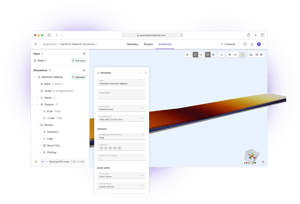Why harmonic balance?
.png?width=64&name=5%20(2).png)
Go straight to steady state in the frequency domain—no long, noisy transients.
.png?width=64&name=6%20(2).png)
Capture higher harmonics created by nonlinearities for a complete picture of system behavior.
.png?width=64&name=7%20(2).png)
Focus on dominant harmonics to cut computation time.

Ideal for complex FEM multiphysics where traditional transient runs are slow or unstable.
How it works
.png?width=300&name=5%20(1).png)
Fields are expressed as a truncated Fourier series (constant + sine/cosine terms at selected harmonics).
%20(1).png?width=300&name=MUTs%20website%20content%20(6)%20(1).png)
The method solves for harmonic coefficients that satisfy the governing equations and couplings at steady state—even when new harmonics are generated by nonlinearity.
.png?width=300&name=7%20(1).png)
Choose only the harmonics that matter; reconstruct time‑signals from harmonic data when needed.
Cloud-powered multiphysics simulation platform
.png?width=60&name=1%20(3).png)
On‑demand memory and cores remove hardware bottlenecks for large models and many harmonics.
.png?width=60&name=2%20(3).png)
Run harmonic balance across coupled physics (e.g., electrostatics, solid mechanics, fluid, heat) with mesh deformation and geometric nonlinearity.
.png?width=60&name=3%20(2).png)
Analyze higher harmonics without simulating all intermediate ones to save compute.
.png?width=60&name=4%20(2).png)
Parallel parameter sweeps (frequency, voltage, load) for rapid design space exploration and metrics like THD.
FAQ
Yes. Reconstruct time‑dependent signals over a period from the solved harmonic coefficients.

See how Allsolve could work for you
Get in touch with us now to see how Allsolve can help with your specific challenges
Case examples and other resources
.jpg?width=300&name=5%20(1).jpg)
White paper
Accelerating MEMS simulations with the harmonic balance method
See examples of the harmonic balance method applied to real-world use cases.
Open white paper →

Case example
Nonlinear systems in the frequency domain with harmonic balance
A comprehensive overview of the method with further details and other examples.
Open the article →

Case example
Optimizing designs by simulating thousands of design variations
Explore a case study covering running thousands of simulations in parallel with Quanscient Allsolve.
Open the article →

See how it could work for you
Submit the form to talk with our experts—we'll respond within 1 business day. You'll learn:
- How Allsolve could fit your use case
- What results to expect (accuracy, runtime, design exploration capabilities and rough cost range)
- How it could plug into your workflow today
Interested in just seeing an on-demand demo? Watch the 3-minute demo here


